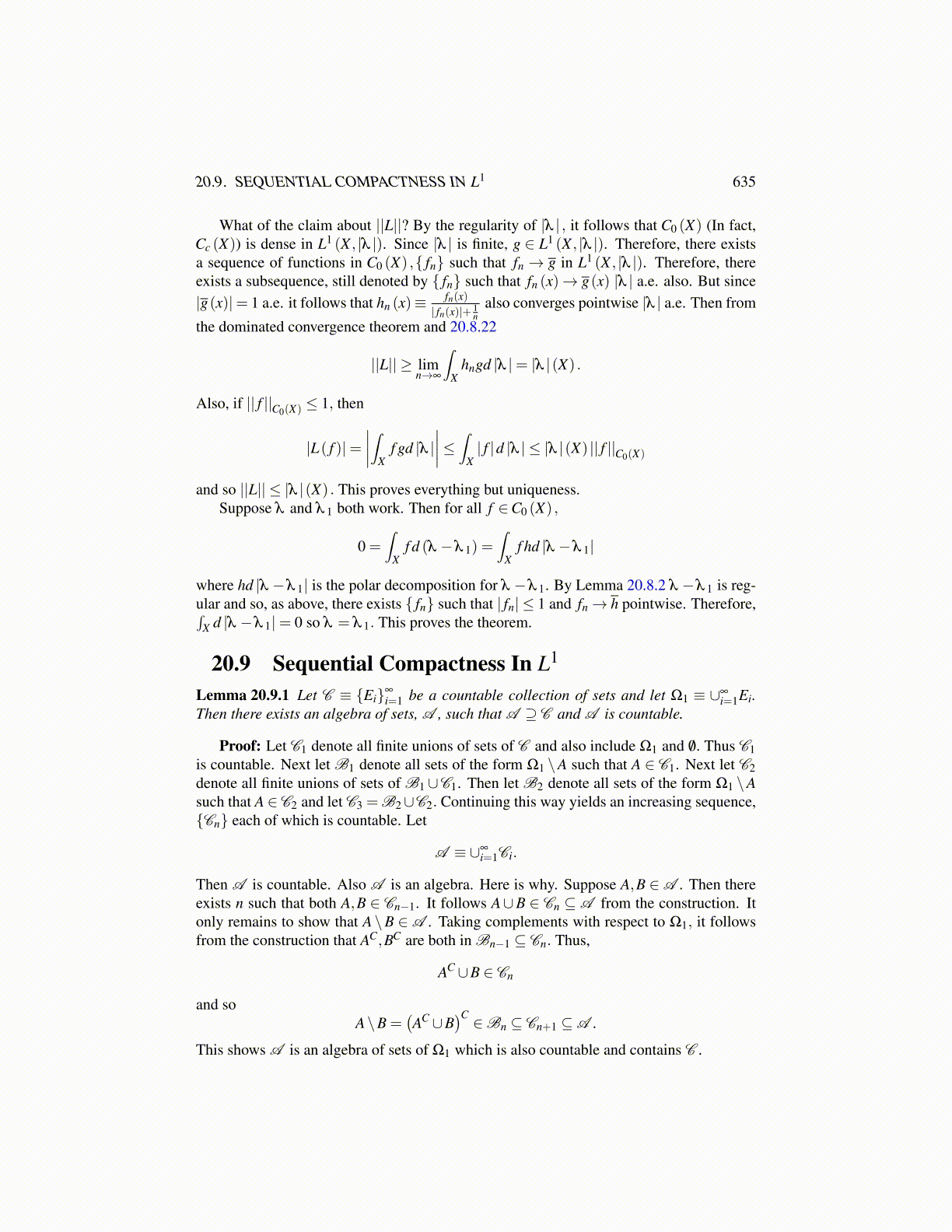
20.9. SEQUENTIAL COMPACTNESS IN L1 635
What of the claim about ||L||? By the regularity of |λ | , it follows that C0 (X) (In fact,Cc (X)) is dense in L1 (X , |λ |). Since |λ | is finite, g ∈ L1 (X , |λ |). Therefore, there existsa sequence of functions in C0 (X) ,{ fn} such that fn → g in L1 (X , |λ |). Therefore, thereexists a subsequence, still denoted by { fn} such that fn (x)→ g(x) |λ | a.e. also. But since|g(x)|= 1 a.e. it follows that hn (x)≡ fn(x)
| fn(x)|+ 1n
also converges pointwise |λ | a.e. Then from
the dominated convergence theorem and 20.8.22
||L|| ≥ limn→∞
∫X
hngd |λ |= |λ |(X) .
Also, if || f ||C0(X) ≤ 1, then
|L( f )|=∣∣∣∣∫X
f gd |λ |∣∣∣∣≤ ∫X
| f |d |λ | ≤ |λ |(X) || f ||C0(X)
and so ||L|| ≤ |λ |(X) . This proves everything but uniqueness.Suppose λ and λ 1 both work. Then for all f ∈C0 (X) ,
0 =∫
Xf d (λ −λ 1) =
∫X
f hd |λ −λ 1|
where hd |λ −λ 1| is the polar decomposition for λ −λ 1. By Lemma 20.8.2 λ −λ 1 is reg-ular and so, as above, there exists { fn} such that | fn| ≤ 1 and fn→ h pointwise. Therefore,∫
X d |λ −λ 1|= 0 so λ = λ 1. This proves the theorem.
20.9 Sequential Compactness In L1
Lemma 20.9.1 Let C ≡ {Ei}∞
i=1 be a countable collection of sets and let Ω1 ≡ ∪∞i=1Ei.
Then there exists an algebra of sets, A , such that A ⊇ C and A is countable.
Proof: Let C1 denote all finite unions of sets of C and also include Ω1 and /0. Thus C1is countable. Next let B1 denote all sets of the form Ω1 \A such that A ∈ C1. Next let C2denote all finite unions of sets of B1∪C1. Then let B2 denote all sets of the form Ω1 \Asuch that A ∈ C2 and let C3 =B2∪C2. Continuing this way yields an increasing sequence,{Cn} each of which is countable. Let
A ≡ ∪∞i=1Ci.
Then A is countable. Also A is an algebra. Here is why. Suppose A,B ∈A . Then thereexists n such that both A,B ∈ Cn−1. It follows A∪B ∈ Cn ⊆ A from the construction. Itonly remains to show that A \B ∈ A . Taking complements with respect to Ω1, it followsfrom the construction that AC,BC are both in Bn−1 ⊆ Cn. Thus,
AC ∪B ∈ Cn
and soA\B =
(AC ∪B
)C ∈Bn ⊆ Cn+1 ⊆A .
This shows A is an algebra of sets of Ω1 which is also countable and contains C .